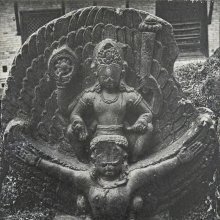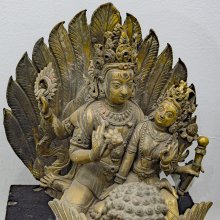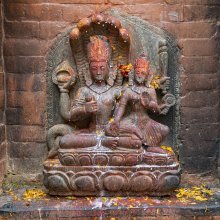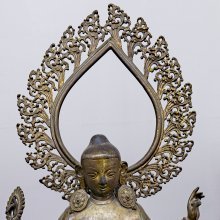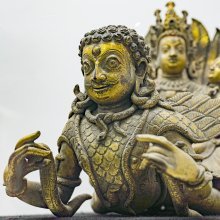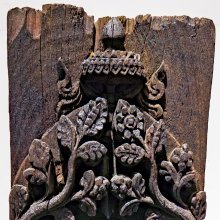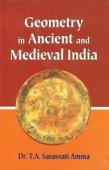Narayana, Nārāyaṇa, Nārāyana, Narāyana, Nara-ayana, Nara-yana: 43 definitions
Introduction:
Narayana means something in Buddhism, Pali, Hinduism, Sanskrit, Jainism, Prakrit, the history of ancient India, Marathi, Hindi. If you want to know the exact meaning, history, etymology or English translation of this term then check out the descriptions on this page. Add your comment or reference to a book if you want to contribute to this summary article.
Alternative spellings of this word include Narayan.
Images (photo gallery)
(+72 more images available)
In Hinduism
Vaishnavism (Vaishava dharma)
Source: humindian: 108 names of Lord KrishnaOne of the 108 names of Krishna; Meaning: "The Refuge Of Everyone"
Source: Pure Bhakti: Bhagavad-gita (4th edition)Nārāyaṇa (नारायण) refers to “the four-armed expansion of Śrī Kṛṣṇa and the all-opulent Lord of Vaikuṇṭha”. (cf. Glossary page from Śrīmad-Bhagavad-Gītā).
Source: Pure Bhakti: Brhad BhagavatamrtamNārāyaṇa (नारायण) refers to:—The shelter (ayana) for mankind (nāra); an expansion of Kṛṣṇa; the Lord of Vaikuṇṭha. (cf. Glossary page from Śrī Bṛhad-bhāgavatāmṛta).
Source: Brill: Śaivism and the Tantric Traditions (vaishnavism)Nārāyaṇa (नारायण) refers to one of the Teachers mentioned in the guruparaṃparā of Vedānta Deśika’s Yatirājasaptati.—The poem’s first ten verses create the context for the exaltation of Rāmānuja. This context is the lineage of teachers (guruparaṃparā) who preceded him and are listed in the first eight verses of the poem in the following order: Nārāyaṇa, Śrī-Lakṣmī, Viṣvaksena, Nammāḻvār, Puṇḍarīkākṣa (Uyyaṅkoṇṭār), Śrīrāmamiśra (Maṇakkāl Nampi), Yāmuna (Āḷavantār) and Mahāpūrṇa (Periya Nampi). In verse 11 Rāmānuja is addressed, for the first time, with the phrase “Lord of the Ascetics” (patiṃ yatīnām).

Vaishnava (वैष्णव, vaiṣṇava) or vaishnavism (vaiṣṇavism) represents a tradition of Hinduism worshipping Vishnu as the supreme Lord. Similar to the Shaktism and Shaivism traditions, Vaishnavism also developed as an individual movement, famous for its exposition of the dashavatara (‘ten avatars of Vishnu’).
Purana and Itihasa (epic history)
Source: archive.org: The Mārkaṇḍeya Purāṇa“Nārā means water and bodies ”—we have thus heard it is a name for water; and in it he lies, hence he is called Nārāyaṇa.
Source: archive.org: The Garuda puranamThe stone known as Nārāyana is of a black colour, contains the mark of a dub-like line in its cavity and has the circular mark at the navel or a little raised up.
Source: archive.org: Puranic EncyclopediaNārāyaṇa (नारायण).—One of the two Ṛṣis famous as Naranārāyaṇas. Birth. Dharma, son of Brahmā was Nārāyaṇa’s father. Dharma married ten daughters of Dakṣa, and four sons, i.e. Hari, Kṛṣṇa, Nara and Nārāyaṇa were born to him of them. Of the four, Nara and Nārāyaṇa were inseparable sannyāsins. In the holy Badarikāśrama on the slopes of the Himālayas they did tapas to please Brahmā for a thousand years. (See full article at Story of Nārāyaṇa from the Puranic encyclopaedia by Vettam Mani)
Source: archive.org: Shiva Purana - English Translation1) Nārāyaṇa (नारायण), literally “having water as abode” is the name of a deity as explained in the Śivapurāṇa 2.1.6, while explaining and enumerating the principles (tattvas):—“from the body of Viṣṇu who thus exerted himself, water-currents (jaladhārā) of various sorts began to flow as a result of Śiva’s Māyā. O great sage, the Supreme Brahman in the form of divine waters pervaded the entire void. A mere contact with the same is destructive of sins. Viṣṇu, the weary person went to sleep amidst the waters. He was in that blissful state of delusion for a long time. As approved in the Vedas, his name came to be established as Nārāyaṇa (Having water as abode). Excepting for that Primordial Being there was nothing then”.
2) Nārāyaṇa (नारायण) or Nārāyaṇasaras is the name of a lake, according to the Śivapurāṇa 2.2.13. Accordingly, as Brahmā said to Nārada:—“[...] advised by their father, O dear one, the sons of Dakṣa [viz., the Haryaśvas] went in the western direction for penance in order to create subjects (progeny). There they came to the holy lake Nārāyaṇa where the celestial Sindhu has its confluence with the ocean. On touching the holy water, their intellect was sharpened. The Dharma of holy ascetics eradicated all their impurities”.
3) Nārāyaṇa (नारायण) is mentioned as another name for Śiva, according to the Śivapurāṇa 2.5.2 (“The Prayer of the gods).—Accordingly, as the Gods eulogized Śiva: “[...] Obeisance to Thee, O lord Nārāyaṇa, devoted to Nārāyaṇa, of the form of Nārāyaṇa, oh! one born of Nārāyaṇa’s body. Obeisance to Thee of all forms, the destroyer of great hells, destroyer of sins. Obeisance to you, O bull-vehicled god. [...]”.
Source: Cologne Digital Sanskrit Dictionaries: The Purana Index1a) Nārāyaṇa (नारायण).—An avatār with Nara; as the Supreme Being; as Puruṣa and Mahāpuruṣa; Protector of the prāṇas; is Kṛṣṇa;1 identified with Veda;2 reincarnated as Aditī's son;3 mantra sacred to;4 the sage of sages;5 the āśrama of;6 born of dharma in the Cākṣuṣa epoch.7 The Lord without birth; same as Viṣṇu, brother of Indra; the last resort of the sages.8 The one who came out of the darkness of mahāpralaya and created the world in its different aspects; his serpent couch on the dark waters described; approach of Brahmā into Nārāyaṇa's stomach, and coming out by way of the lotus;9 permeates the whole universe and pervades the three worlds;10 approached by Śiva to redeem the sin of brahmicide;11 the Vāraha avatār of;12 is Prajāpati, is Brahman;13 is Sādhya with Śrī as wife;14 a compound of Kṣetraja and Prakṛti for the welfare of the world;15 to be remembered in śrāddhas;16 encouraged the Asuras and Devas in the churning of the ocean; praised by Brahmā;17 represents the planet Budha; Urvaśī born of.18
- 1) Bhāgavata-purāṇa I. 2. 4; 3. 9; II. 5. 15-16; 7. 6; 10. 11; IV. 1. 52; V. 26. 38; X. 6. 24; 69. 44; Brahmāṇḍa-purāṇa II. 35. 93; III. 3. 62; 33. 16; 35. 3, 36-40; Vā 104. 58; 109. 23.
- 2) Bhāgavata-purāṇa VI. 1. 40-41.
- 3) Ib. VI. 6. 38.
- 4) Ib. VI. ch. 8. (whole).
- 5) Ib. XI. 16. 25; XII. 8. 32 and 47; 9. 1.
- 6) Ib. VII. 14. 32.
- 7) Brahmāṇḍa-purāṇa III. 71. 196-7; 73. 72.
- 8) Ib. II. 35. 208; III. 3. 102; Matsya-purāṇa 1. 2-3; 154. 352; 164. 27; 172. 3-5; Viṣṇu-purāṇa I. 3. 3, 8. 15; 9. 41; 22. 86.
- 9) Brahmāṇḍa-purāṇa II. 35. 170; IV. 34. 76; Matsya-purāṇa 2. 27-37; 178. 1.
- 10) Vāyu-purāṇa 1. 204; 5. 38; 24. 8-35.
- 11) Matsya-purāṇa 183. 88.
- 12) Brahmāṇḍa-purāṇa I. 4. 27; 5. 3-5; Matsya-purāṇa 247. 6; Vāyu-purāṇa 6. 3-78; 21. 81; 103. 9.
- 13) Matsya-purāṇa 247. 35; Brahmāṇḍa-purāṇa II. 6. 61.
- 14) Vāyu-purāṇa 30. 72.
- 15) Ib. 101. 228.
- 16) Matsya-purāṇa 16. 45.
- 17) Ib. 154. 359; 163. 104; 248. 43; 249. 1, 3-4, 81; 250. 1; 282. 5.
- 18) Brahmāṇḍa-purāṇa II. 24. 49; III. 7. 16.
1b) The name of the last son of Ajāmila.*
- * Bhāgavata-purāṇa VI. 1. 24.
1c) The son of Bhūmimitra Kaṇva; ruled for 12 years:1 Father of Suśarman.2
- 1) Bhāgavata-purāṇa XII. 1. 20; Brahmāṇḍa-purāṇa III. 74. 158; Matsya-purāṇa 272. 34; Vāyu-purāṇa 99. 345.
- 2) Viṣṇu-purāṇa IV. 24. 40-1.
1d) The sage who taught the bhāgavata purāṇa to Nārada who in turn taught it to Vyāsa.*
- * Bhāgavata-purāṇa XII. 4. 41; 13. 10 and 18.
1e) A Sādhya and overlord of the Sādhyas; the Hari of the Svārociṣa epoch.*
- * Brahmāṇḍa-purāṇa III. 3. 17; 8. 6; Matsya-purāṇa 203. 11.
1f) A devaṛṣi.*
- * Vāyu-purāṇa 61. 83.
Nārāyaṇa (नारायण) refers to the name of a Tīrtha (pilgrim’s destination) mentioned in the Mahābhārata (cf. VII.66.38). Note: The Mahābhārata (mentioning Nārāyaṇa) is a Sanskrit epic poem consisting of 100,000 ślokas (metrical verses) and is over 2000 years old.

The Purana (पुराण, purāṇas) refers to Sanskrit literature preserving ancient India’s vast cultural history, including historical legends, religious ceremonies, various arts and sciences. The eighteen mahapuranas total over 400,000 shlokas (metrical couplets) and date to at least several centuries BCE.
Pancaratra (worship of Nārāyaṇa)
Source: Wisdom Library: PāñcarātraNārāyaṇa (नारायण, “Ground of being”):—One of the twenty-four forms of Viṣṇu through which Nārāyaṇa manifests himself. He is accompanied by a counterpart emanation of Lakṣmī (an aspect of Devī) who goes by the name Kānti.
Source: archive.org: Isvara Samhita Vol 1Nārāyaṇa (नारायण) refers to one of the various Vibhava manifestations according to the Īśvarasaṃhitā 24.334-335.—Accordingly, “then God Nārāyaṇa, who is white like a lily, is to be meditated upon. He has formed brahmāñjali, is tranquil, has His mind placed (fixed) in the lotus of His heart and who has joined His self with the Supreme imperishable place”. These Vibhavas (e.g., Nārāyaṇa) represent the third of the five-fold manifestation of the Supreme Consciousness the Pāñcarātrins believe in.

Pancaratra (पाञ्चरात्र, pāñcarātra) represents a tradition of Hinduism where Narayana is revered and worshipped. Closeley related to Vaishnavism, the Pancaratra literature includes various Agamas and tantras incorporating many Vaishnava philosophies.
Shilpashastra (iconography)
Source: archive.org: Pratima Kosa Encyclopedia of Indian Iconography - Vol 6Nārāyaṇa (नारायण) refers to one of the many varieties of the Śālagrāma (ammonite fossil stones).—The Nārāyaṇa stone is dark blue (asita) in colour, an elevation suggesting the navel-lotus and a line in the centre suggesting mace; another account prescribes two lines. Śālagrāma stones are very ancient geological specimens, rendered rounded and smooth by water-currents in a great length of time. They (e.g., Nārāyaṇa stones) are distinguished by the ammonite (śālā, described as “vajra-kīṭa”, “adamantine worms”) which having entered into them for residence, are fossilized in course of time, leaving discus-like marks inside the stone.
Source: academia.edu: Dvādaśa-mūrti in Tamil Tradition (iconography)Nārāyaṇa (नारायण) refers to one of the Dvādaśa-mūrti or “twelve sacred names of Viṣṇu”, whose iconographical details are mentioned in the Śrītattvanidhi (verse 2.19-42) citing the Pāñcarātrāgama-Kriyapāda.—Nārāyaṇa’s Mien (colour of the body) is of the rain-drenched cloud (meghaśyāma-varṇa), pītāmbara (silk is either white or pale yellow), and ornaments of uttama-ratnas. According to the Caturviṃśatimūrtilakṣaṇa, Nārāyaṇa is fitted with the Padma, Śaṅkha, Gāda and Cakra, in that particular order.

Shilpashastra (शिल्पशास्त्र, śilpaśāstra) represents the ancient Indian science (shastra) of creative arts (shilpa) such as sculpture, iconography and painting. Closely related to Vastushastra (architecture), they often share the same literature.
Vyakarana (Sanskrit grammar)
Source: Wikisource: A dictionary of Sanskrit grammar1) Nārāyaṇa (नारायण).—Name of a grammarian who wrote a commentary on the Mahabhsya-Pradipa;
2) Nārāyaṇa.—A grammarian who is said to have written a gloss named Sabdabhusana on the Sutras of Panini as also some minor works named शब्दमञ्जरी, शब्दभेदनिरूपण (śabdamañjarī, śabdabhedanirūpaṇa), etc.

Vyakarana (व्याकरण, vyākaraṇa) refers to Sanskrit grammar and represents one of the six additional sciences (vedanga) to be studied along with the Vedas. Vyakarana concerns itself with the rules of Sanskrit grammar and linguistic analysis in order to establish the correct context of words and sentences.
Shaivism (Shaiva philosophy)
Source: SOAS University of London: Protective Rites in the Netra TantraNārāyaṇa (नारायण) is the name of a four-armed deity, according to the Netratantra of Kṣemarāja: a Śaiva text from the 9th century in which Śiva (Bhairava) teaches Pārvatī topics such as metaphysics, cosmology, and soteriology.—Accordingly, [verse 13.1-9, while describing the appearance and worship of Viṣṇu, in the form of Nārāyaṇa]—“Thus, [I have] spoken the kaulika rule of the mantrarāṭ. I again shall tell another method by which [the deity] grants fruits. He should always think of the four-armed Nārāyaṇa arising. [Nārāyaṇa has] two, long, lotus petal eyes, one face, has the appearance of a [blue] linseed flower, [and is] adorned with all [of his] instruments: a conch, discus, mace, and lotus. [...]”.

Shaiva (शैव, śaiva) or Shaivism (śaivism) represents a tradition of Hinduism worshiping Shiva as the supreme being. Closely related to Shaktism, Shaiva literature includes a range of scriptures, including Tantras, while the root of this tradition may be traced back to the ancient Vedas.
General definition (in Hinduism)
Source: Apam Napat: Indian MythologyNarayana is an appelation of Vishnu. He is also said to be the Godhead portion of the divine twins Nara and Naryana. Along with his twin Nara, he created the divine Urvashi from their thighs.
Source: WikiPedia: HinduismNarayana (Sanskrit: नारायण) is the Vedic Supreme God (including his different avatars) in Hinduism, venerated as the Supreme Being in Vaishnavism. He is also known as Vishnu and Hari and is venerated as Purushottama or Supreme Purusha in Hindu sacred texts such as the Bhagavad Gita, the Vedas and the Puranas.
Narayana is the name of the Supreme God in his infinite all pervading form. He is the Supreme Purusha of Purusha Sukta. The Puranas present a seemingly divergent, but accurate description of Narayana (as an Enlightened Supreme Being). The fifth verse of the Narayana Sukta, a hymn in Yajurveda, states that Narayana pervades whatever is seen or heard in this universe from inside and outside alike. Another important translation of Narayana is The One who rests on Water. The waters are called narah, [for] the waters are, indeed, produced by Nara [the first Being]; as they were his first residence [ayana], he is called Narayana. In Sanskrit, "Nara" can also refer to all human beings or living entities (Jivas). Therefore, another meaning of Narayana is Resting place for all living entities. The close association of Narayana with water explains the frequent depiction of Narayana in Hindu art as standing or sitting on an ocean.
In Hindu sacred texts like Vedas, Puranas etc., Narayana is described as having the divine blue colour of water-filled clouds, four-armed, holding a Padma (lotus flower), mace Kaumodaki, Panchajanya shankha (conch) and a discus weapon Sudarshana Chakra. Narayana is also described in the Bhagavad Gita as having a 'Universal Form' (Vishvarupa) which is beyond the ordinary limits of human perception or imagination.
In Buddhism
Theravada (major branch of Buddhism)
Source: Pali Kanon: Pali Proper Names1. Narayana
The name of a god (Visnu). E.g., Cv.xlvii.25.
2. NarayanaA general of Parakkamabahu I., in charge of Anuradhapura. He rose in rebellion against the king and was slain in battle. Cv.lxxii.65.
3. NarayanaA Damila chief, one of the three Virapparayaras. He was an ally of Lankapura, general of Parakkamabahu I. Cv.lxxvii.6.
Theravāda is a major branch of Buddhism having the the Pali canon (tipitaka) as their canonical literature, which includes the vinaya-pitaka (monastic rules), the sutta-pitaka (Buddhist sermons) and the abhidhamma-pitaka (philosophy and psychology).
Mahayana (major branch of Buddhism)
Source: archive.org: Bulletin of the French School of the Far East (volume 5)Nārāyaṇa (नारायण) is the name of a Gandharva appointed as one of the Divine protector deities of Manijambi, according to chapter 17 of the Candragarbha: the 55th section of the Mahāsaṃnipāta-sūtra, a large compilation of Sūtras (texts) in Mahāyāna Buddhism partly available in Sanskrit, Tibetan and Chinese.—In the Candragarbhasūtra, the Bhagavat invites all classes of Gods and Deities to protect the Law [dharma?] and the faithful in their respective kingdoms of Jambudvīpa [e.g., the Gandharva Nārāyaṇa in Manijambi], resembling the time of the past Buddhas.

Mahayana (महायान, mahāyāna) is a major branch of Buddhism focusing on the path of a Bodhisattva (spiritual aspirants/ enlightened beings). Extant literature is vast and primarely composed in the Sanskrit language. There are many sūtras of which some of the earliest are the various Prajñāpāramitā sūtras.
In Jainism
General definition (in Jainism)
Source: Wisdom Library: JainismNārāyaṇa (नारायण) is the name of the eighth Vāsudeva (“violent heroes”) according to both Śvetāmbara and Digambara sources. Since they enjoy half the power of a Cakravartin (universal monarch) they are also known as Ardhacakrins. Jain legends describe nine such Vāsudevas usually appearing together with their “gentler” twins known as the Baladevas. The legends of these twin-heroes usually involve their antagonistic counterpart known as the Prativāsudevas (anti-heroes).
The parents of as Nārāyaṇa are known as king Daśaratha and queen Kekayī whose stories are related in texts such as the Triṣaṣṭiśalākāpuruṣacarita (“the lives of the sixty-three illustrious persons”), a twelfth-century Śvetāmbara work by Hemacandra.
The nine Vāsudevas (such as Nārāyaṇa) are also known as Nārāyaṇas or Viṣṇus and are further described in various Jain sources, such as the Bhagavatīsūtra and Jambūdvīpaprajñapti in Śvetāmbara, or the Tiloyapaṇṇatti and Ādipurāṇa in the Digambara tradition. The appearance of a Vāsudeva is described as follows: their body is of a dark-blue complexion, they wear a yellow robe made of silk, and they bear the śrīvatsa on their chest.
Source: archive.org: TrisastisalakapurusacaritraNārāyaṇa (नारायण), the son of Kaikeyī and Daśaratha, is one of the nine black Vāsudevas, according to chapter 1.6 [ādīśvara-caritra] of Hemacandra’s 11th century Triṣaṣṭiśalākāpuruṣacaritra: an ancient Sanskrit epic poem narrating the history and legends of sixty-three illustrious persons in Jainism.
According to the Jain Ramayana and chapter 7.4 [Rāma and Lakṣmaṇa]:—“Sumitrā saw an elephant, lion, sun, moon, fire, Śrī, and ocean in a dream at dawn, which indicated the birth of a Viṣṇu. Then a powerful god fell from heaven and descended into Queen Sumitrā’s womb. [...] The king gave him the name Nārāyaṇa; he became known over the earth by another name, Lakṣmaṇa”.
Source: WikiPedia: JainismNārāyaṇa (नारायण) (or Vāsudeva, Viṣṇu) refers to the set of nine “heroes” and counterpart of the antagonistic Prativāsudevas (or Prativiṣṇus, Pratinārāyaṇas), mentioned in both Śvetāmbara and Digambara literature.—In every half time cycle, there are 9 sets of Balabhadras (gentle heroes), Vasudevas (violent heroes) and Prativāsudevas (anti-heroes). Unlike in the Hindu Puranas, the names Balabhadra and Narayana are not restricted to Balarama and Krishna in Jain Puranas. Instead they serve as names of two distinct classes of mighty half brothers, who appear nine times in each half of the time cycles of the Jain cosmology and jointly rule half the earth as half-chakravarti. Ultimately Pratinaryana is killed by Narayana for his unrighteousness and immorality.

Jainism is an Indian religion of Dharma whose doctrine revolves around harmlessness (ahimsa) towards every living being. The two major branches (Digambara and Svetambara) of Jainism stimulate self-control (or, shramana, ‘self-reliance’) and spiritual development through a path of peace for the soul to progess to the ultimate goal.
India history and geography
Source: Wisdom Library: India HistoryNarayana (or, Nārāyaṇa) refers to one of the 84 castes (gaccha) in the Jain community according to Mr. P. D. Jain. The Jain caste and sub-caste system was a comparatively later development within their community, and it may have arisen from the ancient classification of Brāhmaṇa, Kṣatriya, Vaiśya and Śūdra. Before distinction of these classes (such as Narayana), the society was not divided into distinct separate sections, but all were considered as different ways of life and utmost importance was attached to individual chartacter and mode of behaviour.
According to Dr. Vilas Adinath Sangava, “Jainism does not recognise castes (viz., Narayana) as such and at the same time the Jaina books do not specifically obstruct the observance of caste rules by the members of the Jaina community. The attitude of Jainism towards caste is that it is one of the social practices, unconnected with religion, observed by people; and it was none of its business to regulate the working of the caste system” (source).
The legendary account of the origin of these 84 Jain castes (e.g., Narayana) relate that once a rich Jain invited members of the Jain community in order to establish a vaiśya-mahāsabhā (i.e. Central Association of Traders). In response, 84 representatives came from different places, and they were later seen as the progenitors of these castes. Various sources however mention differences in the list.
Source: What is India: Inscriptions of the ŚilāhārasNārāyaṇa Paṇḍita (fl. 1049 AD), son of Tikkapaiya, is mentioned in the “Ṭhāṇā plates of Mummuṇirāja”. Accordingly, Nārāyaṇa Paṇḍita is mentioned amongst fourteen Brāhmaṇas living together, hailing from Karahāṭaka (Karahāṭa), as receiving a gift of several villages. He is associated with the Jāmadagnya-Vatsa gotra (clan)
These copper plates (mentioning Nārāyaṇa) were discovered in 1956 while digging the ground between the Church and the District Office at Ṭhāṇā, the chief town of the Ṭhāṇā District in Mahārāṣṭra. Its object is to record the grant, by the Śilāhāra Mummuṇirāja, of some villages and lands to learned Brāhmaṇas on the occasion of the lunar eclipse on the fifteenth tithi of the bright fortnight of Phālguna in the Śaka year 970, the cyclic year being Sarvadhārin.
Source: What is India: Epigraphia Indica volume XXXI (1955-56)Nārāyaṇa is one of the Brāhmaṇa donees mentioned in the “Asankhali plates of Narasiṃha II” (1302 A.D.). When a grant was made to a large number of Brāhmaṇas, the chief amongst the donees seems to have been called Pānīyagrāhin especially. In the present record, though all the donees (e.g., Nārāyaṇa) are referred to as Pāṇigrāhi-mahājana, their list is headed by a Brāhmaṇa with Pāṇigrahī as his surname.
These copper plates (mentioning Nārāyaṇa) were discovered from the house of a Santal inhabitant of Pargana Asankhali in the Mayurbhanj State (Orissa). It was made when king Vīra-Narasiṃhadeva was staying at the Bhairavapura-kaṭaka (city, camp or residence).
Source: Singhi Jain Series: Ratnaprabha-suri’s Kuvalayamala-katha (history)Nārāyaṇa (नारायण) (=Goviṃda) refers to one of the deities being worshiped in ancient India, as vividly depicted in the Kathās (narrative poems) such as Uddyotanasūri in his 8th-century Kuvalayamālā (a Prakrit Campū, similar to Kāvya poetry).—The Kuvalayamala (779 A.D.) is full of cultural material which gains in value because of the firm date of its composition. [...] Page 256.31-2 ff.: Here is a mixed list of 25 gods and Godlings of all religions. These were worshipped and propitiated to obtain favours. The list includes [e.g., Goviṃda (Nārāyaṇa)] [...].

The history of India traces the identification of countries, villages, towns and other regions of India, as well as mythology, zoology, royal dynasties, rulers, tribes, local festivities and traditions and regional languages. Ancient India enjoyed religious freedom and encourages the path of Dharma, a concept common to Buddhism, Hinduism, and Jainism.
Languages of India and abroad
Marathi-English dictionary
Source: DDSA: The Molesworth Marathi and English Dictionarynarayāna (नरयान).—n S A vehicle carried by men; a palanquin, a dooly, a sedan.
--- OR ---
nārāyaṇa (नारायण).—m (S) A name of viṣṇu, esp. as considered as the Deity who was before all worlds. Pr. aḍalā nā0 gāḍhavācē pāya dharī A man hard up will embrace and supplicate the basest. 2 A cant word among Sanyasis for money. A rupee is called thōra- lā nārāyaṇa, and a pysa dhākaṭā nārāyaṇa. 3 A cant term for the Naru or Guinea-worm.
Source: DDSA: The Aryabhusan school dictionary, Marathi-Englishnarayāna (नरयान).—n A vehicle carried by men; a pa- lanquin, a dooly, a sedan.
--- OR ---
nārāyaṇa (नारायण).—m A name of viṣṇu, esp. as con- sidered as the Deity who was before all worlds. Pr. aḍalā nā?B gāḍhāvācē pāya dharī A man hard up will embrace and supplicate the basest. A cant term for the Na'ru' or Guinea-worm.
Marathi is an Indo-European language having over 70 million native speakers people in (predominantly) Maharashtra India. Marathi, like many other Indo-Aryan languages, evolved from early forms of Prakrit, which itself is a subset of Sanskrit, one of the most ancient languages of the world.
Sanskrit dictionary
Source: DDSA: The practical Sanskrit-English dictionaryNārāyaṇa (नारायण).—1 An epithet of Viṣṇu; (the word is thus derived in Manusmṛti 1.1. āpo nārā iti proktā āpo vai narasūnavaḥ | tā yadasyāyanaṃ pūrvaṃ tena nārāyaṇaḥ smṛtaḥ ||) नारायणं नमस्कृत्य (nārāyaṇaṃ namaskṛtya) ...... ततो जयमुदीरयेत् (tato jayamudīrayet) Mahābhārata (Bombay) 1.1.1; नीरे नीरचरैः समं स भगवान् निद्राति नारायणः (nīre nīracaraiḥ samaṃ sa bhagavān nidrāti nārāyaṇaḥ) Jagannātha Paṇḍita.
2) Name of an ancient sage said to be a companion of Nara and to have produced Urvaśī from his thigh; cf. ऊरूद्भवा नरसखस्य मुनेः सुरस्त्री (ūrūdbhavā narasakhasya muneḥ surastrī) V.1.3; see नरनारायण (naranārāyaṇa) under नर (nara) also.
3) Name of the second month (reckoning from mārgaśīrṣa).
-ṇī 1 An epithet of Lakṣmī the goddess of wealth.
2) An epithet of Durgā.
3) An epithet of Gaṅgā and Gaṇḍakī.
4) Name of a plant (Mar. śatāvarī).
Derivable forms: nārāyaṇaḥ (नारायणः).
--- OR ---
Narāyana (नरायन).—an epithet of Viṣṇu. नराणामयनं यस्मात् तेन नारायणः स्मृतः (narāṇāmayanaṃ yasmāt tena nārāyaṇaḥ smṛtaḥ) Brav.P.
Derivable forms: narāyanaḥ (नरायनः).
Narāyana is a Sanskrit compound consisting of the terms nara and ayana (अयन).
--- OR ---
Narayāna (नरयान).—a vehicle drawn by men, a palanquin; नरयानादवातीर्य (narayānādavātīrya) Par- ṇāl.4.17; Bhāgavata 1.59.37.
Derivable forms: narayānam (नरयानम्).
Narayāna is a Sanskrit compound consisting of the terms nara and yāna (यान). See also (synonyms): nararatha, naravāhana.
Source: Cologne Digital Sanskrit Dictionaries: Edgerton Buddhist Hybrid Sanskrit DictionaryNārāyaṇa (नारायण).—(1) (also Mahā-n°, q.v.; presumably the name of the Hindu god, but used in [Buddhist Hybrid Sanskrit] as a proverbially powerful personage; so also in Pali, see Malalasekara (Dictionary of Pali Proper Names) s.v. Nārā- yana-saṃghāṭa-bala, ‘name given to a certain measure of physical strength…[it] was the strength of the Buddha’; but in MPS 31.21 Buddha has the power of many hundreds of Nārāyaṇas): Nārāyaṇa-balam Mahāvyutpatti 8214 = Tibetan sred med buḥi (of Nārāyaṇa, so [Tibetan-English Dictionary]; lit. seems to mean of son of the desireless one) stobs (strength); °ṇa-sthāmavān Lalitavistara 109.11; 110.8; 291.15 (all verses), having the might of N. (Tibetan on the last, sred med bu yi mthu ldan pa); °ṇa- saṃhananakāyaḥ Saddharmapuṇḍarīka 428.9—10, said of a Bodhisattva; °ṇa-saṃhananaḥ Mūla-Sarvāstivāda-Vinaya i.271.10; vajradṛḍha abhedya nārā- yaṇo ātmabhāvo guru Lalitavistara 202.17 (verse) = Tibetan sku (body) ni sred med bu yi stobs ldan (having the strength of N.), which seems to imply that Tibetan took nārāyaṇo as an adj., Nārāyaṇa-like (in strength); it could perhaps be under- stood as for °ṇa-, in composition with -ātmabhāva (§ 8.12), having the body of a N. (i.e. like N.); sarvaparvasu caikas- min (read caikaikasmin?) parvaṇi Nārāyaṇa-bala-saṃni- viṣṭatā (…a state of being invested with the power of N.) Bodhisattvabhūmi 74.27; see the similar cases s.vv. Ardhanārāyaṇa, Mahānārāyaṇa; (2) name of a Buddha: Śikṣāsamuccaya 169.12; (3) name of a yakṣa: Suvarṇabhāsottamasūtra 161.6; (4) name of a nāga-king: Mahā-Māyūrī 247.4.
Source: Cologne Digital Sanskrit Dictionaries: Shabda-Sagara Sanskrit-English DictionaryNarāyaṇa (नरायण).—m.
(-ṇaḥ) A name of Vishnu. E. nara man, and ayaṇa going; see nārāyaṇa .
--- OR ---
Nārāyaṇa (नारायण).—m.
(-ṇaḥ) 1. A name of Vishnu, but especially considered as the deity who was before all worlds. 2. A sage, and brother of nara . The two great sages, while practising penance at the Badarikashram on the Himalaya, Indra being afraid lest he might be deprived of his throne sent Heavenly nymphs to disturb their devotions; But Narayana put these damsels to shame by creating a nymph (Urvashi by name) from his thigh far excelling Indra's nymph’s in beauty. 3. A valiant combatant. f. (-ṇī) 1. A name of Durga. 2. A name of Lakshmi, the goddess of prosperity, and wife of Vishnu. 3. Ganga. 4. A plant, (Asparagus racemosa.) E. nārā the primeval waters, derived from nara the spirit of God, whence they originated, and ayana place of coming or moving; he who moved over the waters before creation; the word has several etymologies, as nara the spirit or soul of the universe, aṇ affix, nāra appertaining to it, the actions or emotions of the soul, and ayana pervading, influencing; again nāra multitudes, man kind, and ayana place; present amongst all men, &c.
Source: Cologne Digital Sanskrit Dictionaries: Benfey Sanskrit-English DictionaryNārāyaṇa (नारायण).—probably nara + āyana, I. m. 1. The first living being, identified with Viṣṇu or Kṛṣ- ṇa, Mahābhārata 7, 9447; [Mānavadharmaśāstra] 1, 10. 2. A proper name, [Bhāgavata-Purāṇa, (ed. Burnouf.)] 6, 1, 24. Ii. adj. Referring, belonging to Nārāyaṇa. Mahābhārata 1, 337. Iii. f. ṇī, patronym. name of Indrasenā, Mahābhārata 4, 651.
--- OR ---
Narayāna (नरयान).—n. 1. a carriage drawn by men, Mahābhārata 12, 1383. 2. -yāṇa (with ṇ), riding on a man, [Pañcatantra] iii. [distich] 248.
Narayāna is a Sanskrit compound consisting of the terms nara and yāna (यान).
Source: Cologne Digital Sanskrit Dictionaries: Cappeller Sanskrit-English DictionaryNārāyaṇa (नारायण).—1. [masculine] the son of (the primeval) man (cf. nara), often identified with Viṣṇu or Kṛṣṇa; a man’s name.
--- OR ---
Nārāyaṇa (नारायण).—2. [adjective] relating to Nārāyaṇa.
Source: Cologne Digital Sanskrit Dictionaries: Aufrecht Catalogus Catalogorum1) Nārāyaṇa (नारायण) as mentioned in Aufrecht’s Catalogus Catalogorum:—See Gopīnārāyaṇa, Candranārāyaṇa, Jayanārāyaṇa, Naranārāyaṇa, Yajñanārāyaṇa, Rūpanārāyaṇa, Lakṣmīnārāyaṇa, Vīranārāyaṇa, Śivanārāyaṇa, Śeṣanārāyaṇa, Haranārāyaṇa, Harinārāyaṇa.
2) Nārāyaṇa (नारायण):—father of Kṛṣṇadeva (Kṛtyatattva, etc.). L. 3132.
3) Nārāyaṇa (नारायण):—father of Gaṅgārāma (Tarkāmṛtacashaka). Hall. p. 76.
4) Nārāyaṇa (नारायण):—father of Dvivedagaṅga (Mādhyaṃdināraṇyakabhāṣya). W. p. 46. Oxf. 393^b.
5) Nārāyaṇa (नारायण):—father of Bharatasvāmin (Sāmavedavivaraṇa).
6) Nārāyaṇa (नारायण):—father of Mahādeva (Kāmyeṣṭiprayoga). Bp. 288.
7) Nārāyaṇa (नारायण):—father of Viśvanātha Vaidya (Jagatprakāśakāvya). Peters. 3, 354.
8) Nārāyaṇa (नारायण):—son of Rāmeśvara, father of Śaṅkara, grandfather of Raṅganātha, Dāmodara, Nṛsinha and Nīlakaṇṭha (Bhagavantabhāskara). End of Nītimayūkha.
9) Nārāyaṇa (नारायण):—father of Gopāla, grandfather of Padmanābha Dīkṣita (Prayogadarpaṇa). L. 1775.
10) Nārāyaṇa (नारायण):—father of Mādhava, grandfather of Rāmakṛṣṇa (Siddhāntacandrikā). Hall. p. 173.
11) Nārāyaṇa (नारायण):—father of Rāmanātha, grandfather of Rāmagopāla Śarman (Varṇabhairava). L. 280.
12) Nārāyaṇa (नारायण):—prapitāmaha of Candraśekhara, the father of Viśvanātha, wrote on Alaṃkāra. Sāhityadarpaṇa p. 23.
13) Nārāyaṇa (नारायण):—elder brother of Kṛṣṇa Bhaṭṭa Ārḍe (Kāśikā). Hall. p. 31.
14) Nārāyaṇa (नारायण):—brother of Mādhava, uncle of Raghunātha (Kālatattvavivecana) and Viśvanātha. L. 1371.
15) Nārāyaṇa (नारायण):—from Kāśmīra, poet. [Sūktikarṇāmṛta by Śrīdharadāsa] [Subhāshitāvali by Vallabhadeva] See Kavirājanārāyaṇa, Kendranīlanārāyaṇa.
16) Nārāyaṇa (नारायण):—Agniṣṭomaprayoga. Ben. 9. Ācāracaturdaśīpariśiṣṭa. B. 1, 146. Ben. 6. Kautukabandhanaprayoga. B. 1, 220. Cayanapaddhati. Ben. 4. Jīvacchrāddhaprayoga. Khn. 72. B. 1, 222. Mahārudrapaddhati. B. 1, 156. Rudrapaddhati. K. 192. Bhk. 23. Rudrajapavidhi Śāṅkh. B. 1, 192. Vṛddhiśrāddhaprayoga. B. 1, 236. Sthālīpākaprayoga. B. 1, 242.
17) Nārāyaṇa (नारायण):—Adhyātmacintāmaṇivyākhyāna.
18) Nārāyaṇa (नारायण):—Amṛtakumbha jy. B. 4, 114. Grahalāghava. B. 4, 126. Camatkāracintāmaṇi and—[commentary].
19) Nārāyaṇa (नारायण):—pupil of Rāmendra Sarasvatī, wrote commentaries (Dīpikā) on the following Upaniṣads. Compare L. 1472: Atharvaśikhā, Atharvaśiras, Atharvaśīrṣa, Amṛtanāda, Amṛtabindu, Ātmabodha, Ātmavidyā, Āruṇeya, Aitareya, Kāṭhaka, Kālāgnirudra, Kṛṣṇa, Kṛṣṇatāpanīya, Keneṣita, Kaivalya, Kauṣītaka, Kṣurikā, Garbha, Gopālatāpanīya, Gopīcandana, Cūlikā, Jābāla, Tejobindu, Taittirīya, Dhyānabindu, Nādabindu, Nārāyaṇa, Nīlarudra, Nṛsiṃha, Paramahaṃsa, Piṇḍa, Prathamā (?), Praśna, Prāṇāgnihotra, Brahmabindu, Brahmavidyā, Brahmopaniṣad, Bhṛgu, Mahānārāyaṇa, Mahopaniṣad, Māṇḍūkya, Muṇḍaka, Maitreyī, Yogatattva, Yogaśikhā, Rāmatāpanīya, Vāsudeva, Śikhā, Śvetāśvatara, Ṣaḍvaktra, Saṃnyāsa, Sarva, Haṃsa.
20) Nārāyaṇa (नारायण):—Kumārasambhavaṭīkā. Bhāvadīpikā Raghuvaṃśaṭīkā.
21) Nārāyaṇa (नारायण):—Khaṇḍavyākhyānamālā. B. 4, 48.
22) Nārāyaṇa (नारायण):—
—[commentary] on Vallabhācārya’s Jalabheda. Peters. 3, 392.
23) Nārāyaṇa (नारायण):—Ṇatvadarpaṇa. Oppert. Ii, 2047.
24) Nārāyaṇa (नारायण):—Tantravivāhaka jy. Kāśīn. 4.
25) Nārāyaṇa (नारायण):—Daśāvatārotpattisamayadīpikā. Poona. 174.
26) Nārāyaṇa (नारायण):—Dinatrayamīmāṃsā [dharma] Bhr. 617.
27) Nārāyaṇa (नारायण):—Devīmāhātmyaṭīkā. Rādh. 26.
28) Nārāyaṇa (नारायण):—Dharmasubodhinī. Burnell. 130^b.
29) Nārāyaṇa (नारायण):—pupil of Rāghavendra: Nyāyaprāmāṇyamañjarīṭīkā. Io. 1670.
30) Nārāyaṇa (नारायण):—Padmalīlāvilāsinī jy. Peters. 2, 193.
31) Nārāyaṇa (नारायण):—Pārvaṇaśrāddhapradīpabhāṣya. B. 1, 156.
32) Nārāyaṇa (नारायण):—Bhaktibhūṣaṇasaṃdarbha. K. 208. Bhaktisāgara. Np. V, 178.
33) Nārāyaṇa (नारायण):—Bhāgavatapurāṇaṭīkā Cakravartī.
34) Nārāyaṇa (नारायण):—of Govindapurī: Bhāṭṭanayoddyota, based on the Bhāṭṭadīpikā of Khaṇḍadeva. Burnell. 84^a.
35) Nārāyaṇa (नारायण):—Mahābhāṣyapradīpavivaraṇa. Bh. 27.
36) Nārāyaṇa (नारायण):—Mātṛgotranirṇaya. Bhr. 601.
37) Nārāyaṇa (नारायण):—Vilaṅghyalakṣaṇa Taitt.
38) Nārāyaṇa (नारायण):—Viṣṇuśrāddhapaddhati. Peters. 1, 119.
39) Nārāyaṇa (नारायण):—Viṣṇustuti. Oppert. Ii, 5569.
40) Nārāyaṇa (नारायण):—of Govindapura: Śabdabhūṣaṇa, a
—[commentary] on Pāṇini’s grammar. Śabdamañjarī, an introduction to the preceding work. Śabdabhedanirūpaṇa [grammatical] Burnell. 42^a.
—alaṃk. Burnell. 58^a.
41) Nārāyaṇa (नारायण):—Śāradātilakaṭīkā. Pheh. 1.
42) Nārāyaṇa (नारायण):—Śivagītātātparyabodhinī. Oppert. 2071.
43) Nārāyaṇa (नारायण):—Śrutirañjinī alaṃk. Oppert. Ii, 1004.
44) Nārāyaṇa (नारायण):—Sāpiṇḍyakalpalatikā. K. 200.
45) Nārāyaṇa (नारायण):—Somaprayogaṭīkā. NW. 36.
46) Nārāyaṇa (नारायण):—client of Dhavalacandra: Hitopadeśa.
47) Nārāyaṇa (नारायण):—son of Ananta, son of Hari, son of Kṛṣṇa, son of Ananta, wrote in Ṭāparagrāma: Kuṇḍamaṇḍapadarpaṇa. Kh. 75. Muhūrtamārtaṇḍa (composed in 1573) and its
—[commentary] Muhūrtavallabhā (1573).
48) Nārāyaṇa (नारायण):—son of Kṛṣṇajī, grandson of Śrīpati: Śāṅkhāyanagṛhyasūtrabhāṣya, composed in 1573.
49) Nārāyaṇa (नारायण):—son of Goṇa, son of Umāpati, son of Gadā- dhara, son of Bhadreśvara, son of Dharma, son of Paritoṣa: Pariśiṣṭaprakāśa, a
—[commentary] on Keśavamiśra’s Chandogapariśiṣṭa.
50) Nārāyaṇa (नारायण):—son of Dādābhāi, grandson of Mādhava: Tājikasāra. NW. 532. Tājikasārasudhānidhi. Horāsārasudhānidhi. Mentioned Oxf. 333^a.
51) Nārāyaṇa (नारायण):—son of Nṛsiṃha, composed in 1357: Gaṇitapāṭīkaumudī.
52) Nārāyaṇa (नारायण):—son of Nṛsiṃha (Narasiṃha) with the surname Vedarakara: Naiṣadhacaritaprakāśa.
53) Nārāyaṇa (नारायण):—from Malaya, son of Paśupati: Śāṅkhāyanaśrautasūtrapaddhati. W. p. 28. Kh. 60.
—[commentary] on the Praiṣādhyāya of Śāṅkhāyanasūtra. W. p. 29.
54) Nārāyaṇa (नारायण):—son of Maṇḍūri Raghunātha:
—[commentary] on Mādhava’s Gotrapravaranirṇaya.
55) Nārāyaṇa (नारायण):—son of Raṅganātha Dīkṣita, brother of Bālakṛṣṇa: Apekṣitavyākhyāna on Uttararāmacarita, composed in 1764. Kāvyaprakāśaṭīkā. B. 3, 48. Mālatīmādhavaṭīkā. B. 2, 122. Rādhāvinodaṭīkā, written by request of a son of Śukadeva. W. p. 169. L. 1718. Vāsavadattāṭīkā. B. 2, 106. Rādh. 22. Viddhaśālabhañjikāṭīkā. K. 74. Hanumannāṭakaṭīkā. K. 74.
56) Nārāyaṇa (नारायण):—son of Ratnākara: Vāradapūrvatāpanīyopaniṣaddīpikā. Peters. 2, 185.
57) Nārāyaṇa (नारायण):—son of Rāma: Grahaṇalikhanānukrama jy.
58) Nārāyaṇa (नारायण):—son of Lakṣmīdhara, of Brahmadeśāgrahāra in Kāñcīmaṇḍala: Kamalākaṇṭhīrava nāṭaka. Burnell. 167^b.
59) Nārāyaṇa (नारायण):—son of Limba Bhaṭṭa, grandson of Kaṃha Bhaṭṭa, wrote in 1609, by order of king Haridāsa of Benares: Pūrṇānandaprabandha. Hall. p. 136.
60) Nārāyaṇa (नारायण):—son of Śrīpati, son of Jagannātha, son of Bhānu, son of Nīlakaṇṭha, son of Janārdana, son of Āditya, son of Vāmana, son of Caṇḍāṃśu from Gurjara: Śāṅkhāyanaśrautasūtrapaddhati. Peters. 2, 100. 170.
61) Nārāyaṇa (नारायण):—son of Hīra Bhaṭṭa, grandson of Kṛṣṇa: Oṃkāragrantha. Mentioned Oxf. 318^a.
62) Nārāyaṇa (नारायण):—of Kharjūra, father of Śrīpati, grandfather of Guṇākara (Horāmakaranda).
63) Nārāyaṇa (नारायण):—an official to king Nayapāla of Bengal, father of Cakrapāṇidatta, Catal. Io. p. 938.
64) Nārāyaṇa (नारायण):—father of Jñānamalla and Trivikrama (Trivikramaśataka).
65) Nārāyaṇa (नारायण):—father of Pāṇḍuraṅga (Advaitajalajāta).
66) Nārāyaṇa (नारायण):—son of Rāmacandra, father of Rāmabhaṭṭa, grandfather of Lakṣmīnātha (Piṅgalārthapradīpa 1600).
67) Nārāyaṇa (नारायण):—father of Trivikrama, father of Puruṣottama, father of Viśvanātha (Viśvaprakāśapaddhati).
68) Nārāyaṇa (नारायण):—father of Harihara (Ācārasaṃgraha).
69) Nārāyaṇa (नारायण):—Advaitakālānala.
70) Nārāyaṇa (नारायण):—Udāharaṇa of Keśava’s Jātakapaddhati.
71) Nārāyaṇa (नारायण):—son of Ratnākara (q. v.), pupil of Rāmendra Sarasvatī, wrote Dīpikās on the following Upanishads also: Ānandavallī, Gaṇapatipūrvatāpanīya, Garuḍa, Dvitīyā, Nārasiṃhaṣaṭcakra, Bhṛguvallī, Rāma.
72) Nārāyaṇa (नारायण):—Nyāyasudhāṭīkā.
73) Nārāyaṇa (नारायण):—Mokṣadharma.
74) Nārāyaṇa (नारायण):—pupil of Sundararāja: Sūryasiddhāntaṭīkā Siddhāntadīpikā.
75) Nārāyaṇa (नारायण):—Somapaddhati.
76) Nārāyaṇa (नारायण):—Nārāyaṇīpaddhati jy.
77) Nārāyaṇa (नारायण):—composed in 1845: Varadagurupañcāśatstotra.
78) Nārāyaṇa (नारायण):—son of Nṛsiṃha: Tājikadivākara.
79) Nārāyaṇa (नारायण):—with the surname Vedarakara, son of Nṛsiṃha: Devīmāhātmyaṭīkā.
80) Nārāyaṇa (नारायण):—son of Ratnākara, wrote Dīpikāḥ also on: Kalisaṃtaraṇopaniṣad, Kaṭhaśrutyupaniṣad, Brahmavallyupaniṣad, Śikṣāvallyupaniṣad.
81) Nārāyaṇa (नारायण):—a pupil of Kṛṣṇa: Kumārasambhavaṭīkā.
82) Nārāyaṇa (नारायण):—Nītimālā.
83) Nārāyaṇa (नारायण):—son of Veṅkaṭādri: Jayamaṅgalā, a C. to the Lalitāsahasranāman from the Brahmāṇḍapurāṇa. Whish 34.
Source: Cologne Digital Sanskrit Dictionaries: Monier-Williams Sanskrit-English Dictionary1) Narayāṇa (नरयाण):—[=nara-yāṇa] [from nara] n. a carriage drawn by men, [Mahābhārata; Pañcatantra; Bhāgavata-purāṇa]
2) Narayāna (नरयान):—[=nara-yāna] [from nara] n. a carriage drawn by men, [Mahābhārata; Pañcatantra; Bhāgavata-purāṇa]
3) Narāyaṇa (नरायण):—[from nara] [wrong reading] for nār.
4) Nārāyaṇa (नारायण):—[from nāra] a m. ([patronymic] [from] nara q.v.) the son of the original Man (with whom he is generally associated e.g. [Manu-smṛti i, 10]; he is identified with Brahmā, [ib. 11] with Viṣṇu or Kṛṣṇa, [Taittirīya-āraṇyaka; Mahābhārata] etc.; the Apsaras Urvaśī is said to have sprung from his thigh, [Harivaṃśa 4601]; elsewhere he is regarded as a Kaśyapa or Aṅgirasa, also as chief of the Sādhyas, and with Jainas as the 8th of the 9 black Vāsudevas)
5) [v.s. ...] the Puruṣa-hymn ([Ṛg-veda x, 90], said to have been composed by N°), [Śatapatha-brāhmaṇa; Śāṅkhāyana-śrauta-sūtra]
6) [v.s. ...] (as synonym of Viṣṇu) Name of the 2nd month (reckoning from Mārgaśīrṣa), [Varāha-mihira]
7) [v.s. ...] a mystical Name of the letter ā, [Upaniṣad]
8) [v.s. ...] Name of a son of Ajā-mila, [Bhāgavata-purāṇa]
9) [v.s. ...] of a son of Bhū-mitra or Bhūmi-mitra (a prince of the dynasty of the Kāṇvāyanas), [Purāṇa]
10) [v.s. ...] of a son of Nara-hari, [Kṣitīśa-vaṃśāvalī-carita]
11) [v.s. ...] of sub voce men, authors and commentators (also with ācārya. kavi, gārgya, cakra-cūḍāmaṇi, daiva-vid, dharmādhikārin, paṇḍina, paṇḍita, dharmādkikāriṅ paṇḍitācārya, parivrāj, bhaṭṭa cf. below, and bhaṭṭa-n, bhaṭṭācārya, bhaṭṭāraḍa, bhāratī, bhiṣaj, muni, yati, yatīvara, rāya, vandya, vādīśvara, vidyā-vinoda, vaiṣṇava-muni, śarman, sarasvatī, sarva-jña, sārvabhauma)
12) [v.s. ...] mf(ī)n. relating or belonging to Nārāyaṇa or Kṛṣṇa, [Mahābhārata] etc. (m. [plural] the warriors of K°, [iv, 147])
13) [v.s. ...] n. (with kṣetra) Name of the ground on the banks of the Ganges for a distance of 4 cubits from he water, [cf. Lexicographers, esp. such as amarasiṃha, halāyudha, hemacandra, etc.]
14) [v.s. ...] (with cūrṇa) a [particular] medicinal powder, [Bhāvaprakāśa]
15) [v.s. ...] (with taila) a [medicine] oil expressed from various plants, [ib.]
16) b See above.
Source: Cologne Digital Sanskrit Dictionaries: Yates Sanskrit-English Dictionary1) Narāyaṇa (नरायण):—[narā+yaṇa] (ṇaḥ) 1. m. Vishnu.
2) Nārāyaṇa (नारायण):—[nārā+yaṇa] (ṇaḥ) 1. m. A name of Vishnu; a sage; a combatant. f. (ṇī) Durgā; Lakshmī; Gaṃgā; asparagus.
Source: DDSA: Paia-sadda-mahannavo; a comprehensive Prakrit Hindi dictionary (S)Nārāyaṇa (नारायण) in the Sanskrit language is related to the Prakrit words: Ṇarāyaṇa, Ṇārāyaṇa.
[Sanskrit to German]
Sanskrit, also spelled संस्कृतम् (saṃskṛtam), is an ancient language of India commonly seen as the grandmother of the Indo-European language family (even English!). Closely allied with Prakrit and Pali, Sanskrit is more exhaustive in both grammar and terms and has the most extensive collection of literature in the world, greatly surpassing its sister-languages Greek and Latin.
Hindi dictionary
Source: DDSA: A practical Hindi-English dictionaryNārāyaṇa (नारायण) [Also spelled narayan]:—(nm) God, Lord Vishnu.
...
Prakrit-English dictionary
Source: DDSA: Paia-sadda-mahannavo; a comprehensive Prakrit Hindi dictionary1) Ṇarāyaṇa (णरायण) in the Prakrit language is related to the Sanskrit word: Nārāyaṇa.
2) Ṇārāyaṇa (णारायण) also relates to the Sanskrit word: Nārāyaṇa.
3) Ṇārāyaṇa (णारायण) also relates to the Sanskrit word: Nārāyaṇa.
Prakrit is an ancient language closely associated with both Pali and Sanskrit. Jain literature is often composed in this language or sub-dialects, such as the Agamas and their commentaries which are written in Ardhamagadhi and Maharashtri Prakrit. The earliest extant texts can be dated to as early as the 4th century BCE although core portions might be older.
Kannada-English dictionary
Source: Alar: Kannada-English corpusNarayaṇa (ನರಯಣ):—[noun] the variant spelling of 'ನಾರಾಯಣ [narayana]'.
--- OR ---
Nārāyaṇa (ನಾರಾಯಣ):—
1) [noun] the primordial Power of the universe.
2) [noun] Viṣṇu, one of the Hindu Trinities, conceived as the embodiment of properties as mercifulness, goodness, etc. and the preserver of the universe.
3) [noun] Křṣṇa, the eighth incarnation of Viṣnu.
Kannada is a Dravidian language (as opposed to the Indo-European language family) mainly spoken in the southwestern region of India.
See also (Relevant definitions)
Partial matches: Nara, Yana, Ayana.
Starts with (+153): Narayana acarya, Narayana bharati, Narayana bhatta, Narayana bhatta arada, Narayana bhattacarya, Narayana bhishaj, Narayana cakracudamani, Narayana cakravartin, Narayana daivajna, Narayana daivavid, Narayana dharmadhikarin, Narayana dikshita, Narayana gargya, Narayana kavi, Narayana Mangalam, Narayana Mangalam, Narayana Mangalath Mana, Narayana Mangalath Mana, Narayana muni, Narayana Pandita.
Ends with (+64): Adinarayana, Agninarayana, Anantanarayana, Anupanarayana, Ardhanarayana, Ashrvatthanarayana, Ashvatthanarayana, Badarinarayana, Bhatta narayana, Bhattanarayana, Brihonarayana, Cakranarayana, Camgunarayana, Candranarayana, Chakranarayana, Chalari narayana, Darpanarayana, Dharmonarayana, Divalakhoranarayana, Gargya Narayana.
Full-text (+1977): Narayanamaya, Narayanastra, Badarika, Naranarayana, Makanarayanam, Brahmayana, Satya Narayana, Shabdamanjari, Vasudeva, Mahanarayana, Narayanabhatti, Narayanapriya, Narayanam, Nappu, Mahalakshmi, Narayaniya, Sadhanadipika, Gambhirasvamin, Narayanasaras, Natanarayana.
Relevant text
Search found 210 books and stories containing Narayana, Nārāyaṇa, Nārāyana, Narāyana, Nara-ayana, Nara-yana, Narayāna, Nara-yāna, Narāyaṇa, Narayāṇa, Nara-yāṇa, Ṇarāyaṇa, Ṇārāyaṇa, Narayaṇa; (plurals include: Narayanas, Nārāyaṇas, Nārāyanas, Narāyanas, ayanas, yanas, Narayānas, yānas, Narāyaṇas, Narayāṇas, yāṇas, Ṇarāyaṇas, Ṇārāyaṇas, Narayaṇas). You can also click to the full overview containing English textual excerpts. Below are direct links for the most relevant articles:
Lord Hayagriva in Sanskrit Literature (by Anindita Adhikari)
Central Myth (1): Nārāyaṇa as Virāṭ Puruṣa < [Chapter 3]
The central myth of Hayaśīra-Viṣṇu (Introduction) < [Chapter 3]
Central Myth (6): Slaying of the demons Madhu-Kaiṭabha < [Chapter 3]
Manusmriti with the Commentary of Medhatithi (by Ganganatha Jha)
Verse 1.10 < [Section VI - Meaning of the term ‘Nārāyaṇa’]
Verse 9.121 < [Section XVI - Detailed Laws of Partition among Sons]
Verse 8.45 < [Section XI - General Rules regarding Judicial Proceedings]
Garga Samhita (English) (by Danavir Goswami)
Verse 2.9.35 < [Chapter 9 - Brahmā’s Prayers]
Verse 2.24.33 < [Chapter 24 - The Story of Asuri Muni in the Rāsa-dance Pastime]
Verse 1.1.1 < [Chapter 1 - Description of Śrī-Kṛṣṇa’s Glories]
Śrī Kṛṣṇa-vijaya (by Śrī Gunaraja Khan)
Chapter 8 - Indra's Prayers to Lord Kṛṣṇa (Pāhiḍā-rāga)
Chapter 1 - Invoking Auspiciousness
Chapter 5 - Kuvera's Two Sons Offer Prayers to Lord Kṛṣṇa (Vibhāṣā-rāga)
Brihad Bhagavatamrita (commentary) (by Śrī Śrīmad Bhaktivedānta Nārāyana Gosvāmī Mahārāja)
Verse 2.2.107 < [Chapter 2 - Jñāna (knowledge)]
Verse 2.3.92-93 < [Chapter 3 - Bhajana (loving service)]
Verse 2.4.147 < [Chapter 4 - Vaikuṇṭha (the spiritual world)]
The Devi Bhagavata Purana (by Swami Vijñanananda)
Related products
(+4 more products available)
